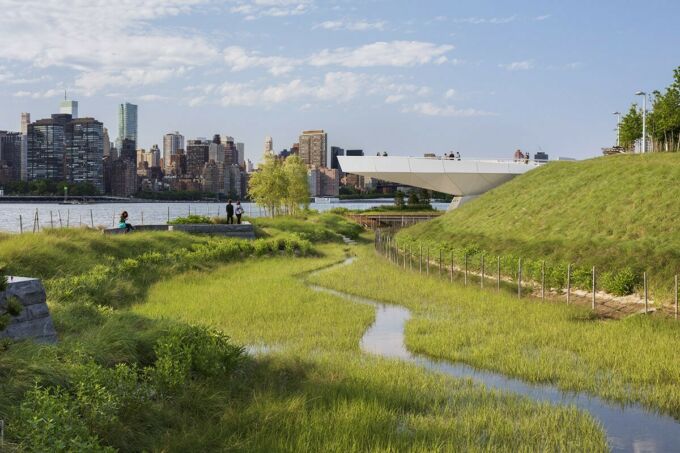July 17, 2019
Two Stuckeman School faculty members to lead Case Study Investigation program

Penn State Stuckeman School faculty members Hong Wu and Lisa DuRussel were selected by the Landscape Architecture Foundation (LAF) to lead teams for the Case Study Investigation (CSI) program. CSI is a unique research collaboration that matches faculty-student research teams with design firms to document the benefits of exemplary high-performing landscape projects. The teams develop methods to quantify environmental, economic and social benefits of design sites. Each Case Study Brief is published in LAF's award-winning Landscape Performance Series.
“The CSI program is important because assessment of design sites can positively impact the landscape architecture profession,” said Wu, adding it is a critical part of the process in order to learn from past successes and failures and to communicate the value of the landscape architecture profession.
DuRussel, assistant teaching professor of landscape architecture, is one of seven faculty across the nation in 2017-2018 granted a LAF Research Fellowship. Her team, which also includes master's student Aastha Singh, evaluated two project sites in the New York City area: (1) the Mathews Nielsen Landscape Architects (MNLA) designed West Point Foundry Preserve (WPFP) in Cold Spring, NY, and (2) the SWA/Balsley-designed Hunters Point South Park (HPS) in Long Island City, Queens. Both studies aim to expose the complexities embedded within landscape architectural designs.
The WPFP project is located on the Hudson River and showcases sculptural re-interpretations of historic artillery and ironworks features. These sculptures serve a dual purpose: they allow visitors to explore and learn about the archaeological heritage of the site, and they are strategically placed to prevent disturbances to areas that have yet to be archaeologically investigated. DuRussel’s team is evaluating the project’s effectiveness in environmental and cultural preservation, including the educational, recreational, and social benefits of the design.
In a more urban context, the HPS project uses sustainable materials in landscape form-making as a means to control flooding and aid in overall resiliency.
“At HPS, the East River shoreline along the park was designed with a variety of techniques to withstand and accommodate future flooding, acting as the first line of defense for what is anticipated to become a densely developed residential quarter in Long Island City,” explained DuRussel. “The design makes it difficult, but not impossible, for storm surge to enter the site.”
For both projects, DuRussel’s team is utilizing digital media as a means for data collection: “In our tech-savvy world, where social media is popular enough that many first-time—and repeat!—users post about their visits, RSVP to an event via the web, or post digital photographs, potential exists to study hashtags and geotagging as a means to inspire and develop a series of datasets to inform research,” she said, noting they are able to apply this technique to assess the “scenic and visual qualities” enhanced by the parks’ designs.
DuRussel’s CSI projects will be completed August 2018 and the results will be published by summer 2019.
Wu, assistant professor of landscape architecture, recently completed her case studies supported by the 2017-2018 LAF fellowship. Her extensive team included: research assistants Clarissa Ferreira Albrecht da Silveira (former Ph.D. student in architecture at Stuckeman School and assistant professor at Federal University of Viçosa, Brazil) and Jie Yang and Yan Yu (master's of landscape architecture candidates at Stuckeman School). Their team partnered with firm liaisons: Jie Hu, vice president of landscape architects at the Research Center for Landscape Architecture Planning from the Tsinghua Tongheng Urban Planning and Design Institute in Beijing, China and William E. Wenk, principal of Wenk Associates, Inc.
The team conducted three case studies: two in China and one in the United States. Yanxiu Park in Liaoyang City, China, was designed by Beijing Tsinghua Tongheng Urban Planning & Design Institute (THUPDI). This riverfront public park is in the floodplain of China’s Taizi River in an area of high-density development in the city of Liaoyang. This area was previously forbidden to development because it floods one week a year. By challenging regulations and incorporating resilient design, Wu said the design employs several sustainable solutions. “The steep banks of the Taizi River and ponds were reshaped to provide more intimate human-water interactions as well as riparian habitat,” she explained. They incorporate new habitat systems, cultural facilities, and recreational opportunities while keeping primary paths, pavilions, restrooms, and viewing platforms above the flood level.
TAXI II was designed by Wenk Associates, Inc. TAXI II is the second phase of the TAXI Redevelopment Project, which transformed a former taxi dispatch center—built on a former landfill—into a thriving mixed-use community along the South Platte River in Denver, Colorado. They integrate stormwater gardens with multi-use outdoor spaces, accommodating a broad range of social events. Utilizing recycled industrial materials they created the site furnishings and landscape elements. It has become a favored location for businesses and has expanded to include diverse housing and community needs.
Huludao-Xingcheng Coastal Trail was also designed by the Research Center for Landscape Architecture Planning at Beijing THUPDI. According to Wu, the project site connects cultural and natural resources (keeping the trees and protecting the shoreline). It has become an invaluable destination and the trail has measurably increased local outdoor activity, social interactions, and revenue without compromising the area’s sensitive coastal system. The new 3.7-mile trail is a backbone that connects two Chinese coastal cities renowned for their beaches along the Bohai Sea.
Wu said the LAF fellowship CSI process allowed her to look at the “big picture.”
“By accepting the challenge of integrating rigorous evaluation criteria into the landscape architecture design and education processes, and by demanding evidence of landscape performance, we not only strengthen the integrity and value of the profession, but also better confront the important environmental challenges that our field is so well-positioned to address.”
You can read more about all the CSI projects online.
